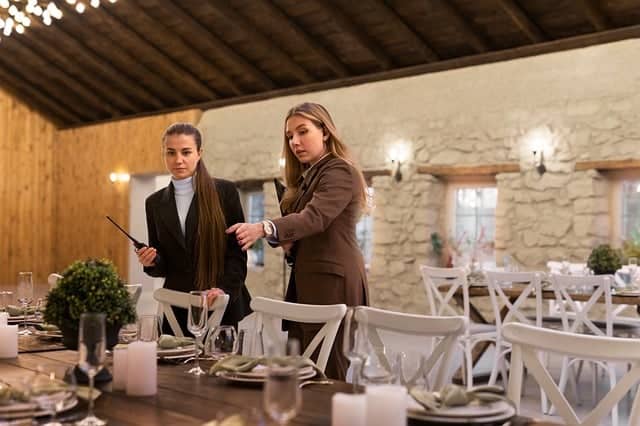Event execution is where months of planning culminate in a single day or a series of days where every detail matters. A seamless event is the result of strategic planning, precise coordination, and meticulous execution. This checklist is designed to guide event managers, planners, and coordinators through the essential steps required for flawless event delivery. Whether you’re hosting a small workshop or a large conference, this guide will ensure nothing is overlooked.
Phase 1: Pre-Planning

Define Event Objectives
- Understand the purpose of the event (e.g., networking, education, celebration).
- Identify specific goals: attendance numbers, lead generation, revenue, awareness.
- Determine success metrics (KPIs).
Understand the Target Audience
- Demographics (age, profession, interests).
- Preferences (food, entertainment, engagement).
- Accessibility needs.
Establish Budget
- Determine available funds.
- Allocate for major components: venue, catering, entertainment, tech, marketing.
- Include contingency (10–20%).
- Set up a budget tracker.
Build a Planning Team
- Define roles: project manager, logistics coordinator, marketing lead, etc.
- Assign responsibilities.
- Establish communication channels.
Phase 2: Planning & Coordination

Choose Date and Venue
- Select a date avoiding conflicts with major holidays or local events.
- Ensure venue capacity matches expected attendance.
- Confirm venue availability and secure with deposit.
- Evaluate venue services: parking, AV equipment, Wi-Fi, accessibility.
Create a Detailed Timeline
- Backward plan from the event date.
- Set deadlines for each planning stage.
- Incorporate vendor timelines and delivery schedules.
Develop Event Program
- Outline agenda: sessions, breaks, keynotes, entertainment.
- Confirm speakers and facilitators.
- Plan transitions between sessions.
Source and Secure Vendors
- Catering, audiovisual, decorators, furniture rental, security, photographers.
- Get quotes and compare services.
- Read and sign contracts.
Plan Technology and Equipment
- Audio/visual needs: mics, speakers, projectors, lighting.
- Registration/check-in tools.
- Wi-Fi access and backup power.
Design Event Branding
- Create logo, theme, and tagline.
- Develop signage, banners, backdrops.
- Ensure consistency across all materials.
Phase 3: Marketing and Promotion

11. Develop a Marketing Plan
- Define target reach and channels.
- Schedule promotional calendar.
12. Create Promotional Materials
- Digital: emails, social media, website, videos.
- Print: flyers, posters, brochures.
- Press releases and media outreach.
13. Launch Registration
- Choose a platform (e.g., Eventbrite, Cvent).
- Collect essential attendee data.
- Send confirmation and reminders.
14. Engage Your Audience Pre-Event
- Send teaser content.
- Use countdowns and interactive posts.
- Encourage sharing via event hashtag.
15. Coordinate with Sponsors and Partners
- Confirm deliverables.
- Provide promotional materials.
- Arrange sponsor booths, banners, and mentions.
Phase 4: Final Preparation

16. Finalize Attendee List
- Verify registrations.
- Print badges/tickets.
- Plan seating or table arrangements.
17. Confirm All Vendors
- Reconfirm arrival time, services, and contacts.
- Schedule vendor walkthrough.
- Share venue rules and timelines.
18. Prepare Staff and Volunteers
- Conduct training sessions.
- Distribute contact lists and roles.
- Review emergency procedures.
19. Assemble Event Kits
- Materials: pens, notebooks, signage, name tags.
- Emergency supplies: first aid, chargers, duct tape.
- Check-in devices: tablets, barcode scanners.
20. Rehearse and Walkthrough
- Conduct a full run-through.
- Test AV equipment and transitions.
- Simulate check-in and session changes.
Phase 5: Event Execution

21. Setup and Check-In
- Arrive early with setup crew.
- Decorate and test all equipment.
- Ensure signage and directions are clear.
- Open registration desk with friendly staff.
22. Manage the Schedule
- Keep sessions on time.
- Monitor transitions and breaks.
- Address any delays proactively.
23. Monitor Vendor Performance
- Ensure food service is timely and correct.
- Confirm AV tech is available for support.
- Have backup contacts ready.
24. Support Attendees
- Provide help desk or info booth.
- Ensure accessibility support.
- Handle complaints or issues swiftly.
25. Document the Event
- Take photos and videos.
- Collect testimonials.
- Monitor social media and live feedback.
Phase 6: Post-Event Activities
26. Break Down and Cleanup
- Oversee vendor exit.
- Pack up materials and signage.
- Check for lost items.
27. Thank You Notes
- Send messages to attendees, speakers, sponsors, and volunteers.
- Include highlights and key outcomes.
28. Collect Feedback
- Send surveys via email.
- Include questions about logistics, content, and overall experience.
- Offer incentives for responses.
29. Evaluate Event Success
- Analyze feedback, attendance numbers, budget performance.
- Review photos and videos.
- Identify areas for improvement.
30. Post-Event Reporting
- Prepare a summary report.
- Include KPIs, budget analysis, attendee feedback, and lessons learned.
- Share with stakeholders.
